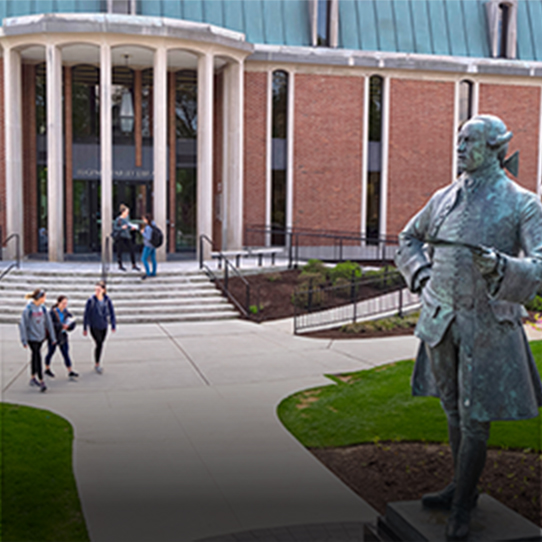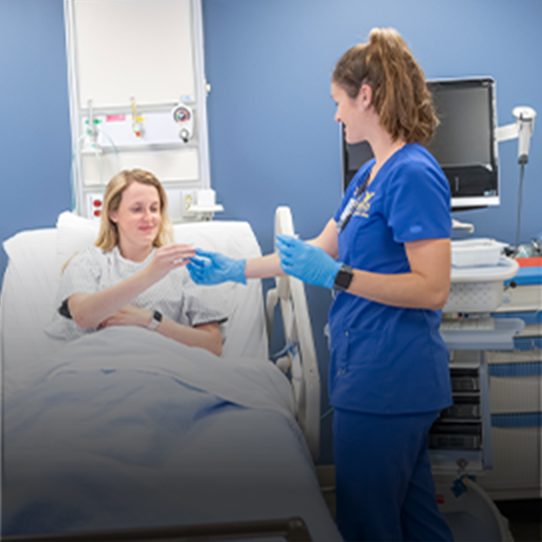How to Become a Family Nurse Practitioner

People who are currently licensed as a registered nurse (RN) with a Bachelor of Science in Nursing (BSN) degree or associate’s degree in nursing (ADN) may be considering how to become a family nurse practitioner (FNP), a role that offers more autonomy in the practice of nursing and an expanded skill set for patient care. Alternatively, licensed RNs who hold an MSN degree in another nursing specialty may be looking to change focus and specialize in family-focused primary care. In any case, if you are wondering about how to become an FNP, this guide is for you.
The National Organization of Nurse Practitioner Faculties (NONPF) is dedicated to the education of nurse practitioners (NPs) using established principles, which in turn guide faculty members who are teaching students how to become a nurse practitioner. In their document outlining the core competencies for nurse practitioners, they state, “The NP Core Competencies are acquired through mentored patient care experiences with an emphasis on independent and interprofessional practice; analytic skills for evaluating and providing evidence-based, patient-centered care across settings; and advanced knowledge of the health care delivery system.”
Of course, this knowledge and skill set do not operate in a vacuum. Nurse practitioners have become a vital part of health care delivery since the role was created in 1965 to address the need for patient care in areas where there were too few physicians to provide it. Over time, the NP role evolved, and education requirements have evolved to now require accredited graduate-level educational program completion in order to be certified, which is required for APRN licensure. NPs may enroll in programs geared toward specific populations, such as neonates, women or those with mental health concerns.
The specialization that has attracted the greatest number of NPs, however, is family practice. Family nurse practitioners care for patients of any age and can work in a wide array of settings.

What is a Family Nurse Practitioner?
A family nurse practitioner is an advanced practice registered nurse (APRN) who has selected family practice as his or her field of interest. The path to becoming an FNP begins when a registered nurse enrolls in a Master of Science in Nursing (MSN) or Doctor of Nursing Practice (DNP) program.
There are quite a number of specialized roles for nurse practitioners. Family practice is the concentration selected by the largest number of nurse practitioners in the U.S., according to the American Association of Nurse Practitioners (AANP). They report that 69.7% of all nurse practitioners are FNPs.
Why Become a Family Nurse Practitioner?
There are many reasons to become a family nurse practitioner. Some people like the prospect of operating with greater autonomy when directing patient care. Others prefer a schedule that is more settled and allows predictability to balance work and home life. Still others appreciate the leadership opportunities within a small practice or larger health system.
Another reason to become an FNP is to be able to provide care to patients and families in areas where it is most needed. The Association of American Medical Colleges projects a shortfall of between 21,400 and 55,200 physicians in primary care alone by 2033. Family nurse practitioners can fill this need and provide this care.
One compelling reason to become an FNP is job satisfaction. Many nurse practitioners derive great satisfaction from helping people promote and maintain their health. In fact, some people feel called to serve in the role. Moreover, in its list of 100 Best Jobs of 2022, U.S. News & World Report ranked nurse practitioner as the No. 2 best job overall and the No. 1 best health care job. In addition, the U.S. Bureau of Labor Statistics (BLS) predicts that there will be a 52% increase in nurse practitioner positions between 2020–2030, so there is excellent job security for the role.

What Do Family Nurse Practitioners Do?
The majority of family nurse practitioners provide primary health care for patients across the life span, from infants to seniors. FNPs manage annual check-ups, order and follow up on screenings, as well as care for common acute ailments and injuries and manage stable chronic illnesses.
This list of services from the AANP gives an overview of how FNPs provide primary care on a regular basis:
- Perform physical examinations
- Manage a patient’s care
- Order or perform diagnostic tests, such as lab work or X-rays
- Diagnose and treat acute and chronic conditions
- Prescribe medications and other treatments
- Offer counseling
- Educate patients on healthy lifestyle choices to prevent disease
- Refer patients to specialists and manage care transfers
- Assist in minor surgeries
The ability to be a touchpoint for multiple members of a family is convenient for patients as well as satisfying to the practitioner, who can follow through on care and patient education in a more comprehensive manner. For example, if a parent and child both present with an odd rash after a camping trip, the FNP can diagnose both patients and provide suitable treatment plans for each, as well as maintain care across the developmental spectrum so as to have longevity with the patient which builds trust and continuity. The ability of the FNP to maintain a care relationship with patients over many years builds trust and continuity.
What Skills Do Family Nurse Practitioners Need?
FNPs need to be able to draw on the wide range of knowledge and skills they receive as part of their nursing education. They build upon the clinical skills in patient assessment, evaluating patient outcomes, and working with interdisciplinary teams they developed as an RN, and they bring additional competencies, such as advanced capabilities in:
- Assessment, pathophysiology and assessment
- Diagnosis, pathophysiology and critical thinking as they apply to nursing theory and evidence-based practice
- Design, practice and applicability of research to advance nursing practice
- Understanding health policy and organizations, and how to work within them
- Providing care and education to patient populations with sensitivity to a patient’s culture, background and life stage
An FNP should also be able to call upon skills to aid them in roles where they have to be a counselor, advocate, educator, manager or mentor.
A well-regarded and accredited master’s, post-master’s certificate, or DNP program will prepare FNPs with these skills.

How Much Do Family Nurse Practitioners Earn?
Nurse practitioners are a major force in care delivery in the U.S. with more than 1 billion patient interactions every year. In areas where primary care physician numbers are low, such as nonmetropolitan and rural areas, FNPs and other nurse practitioners are having a large impact.
Nationally, median FNP salary levels are in the six-figure range. The BLS reports the mean annual salary for nurse practitioners is $114,510 or $55.05 per hour.
What is the Job Outlook for Family Nurse Practitioners?
As the population ages, more adults will need care to address both chronic and acute health problems. Family nurse practitioners are well-positioned to provide this care and the number of job positions for them will continue to grow for the foreseeable future. The BLS projects that there will be a 52% job growth rate for nurse practitioners between 2020 and 2030, which is a very high rate when compared to the national job growth rate of 8% for all occupations.
Where Do Family Nurse Practitioners Work?
While most FNPs work in a clinic or private practice, family nurse practitioners can work in a variety of settings, including:
- Community centers
- Correctional facilities
- Government health centers
- Hospital outpatient clinics
- Hospital emergency rooms/departments (non-life threatening cases)
- Long-term care facilities
- Private practices, either as the lead provider or with other clinicians
- Public health departments
- Retail clinics like the ones attached to pharmacies or big-box retailers
- Rural health centers
- School clinics or university health centers
- Urgent/immediate care clinics
With certain exceptions, FNPs are able to care for patients across the lifespan in these settings and in some cases, are a population’s only source of primary care.

What Are the Work Hours of a Family Nurse Practitioner?
An FNP will likely have a 40-hour workweek, but that is highly dependent on the setting in which the FNP works. An FNP in a long-term care facility might have a scheduled workweek of five 8-hour days, but might in fact have one or more of those days stretch to 10 or even 24 hours if patient care requires it and it is common for individuals who work in primary care or outpatient to have to take call on evenings or weekend.
FNPs working in a private practice, retail clinics or community centers might have greater control over the regularity of their schedule, especially if the facility has standing hours of operation.
FNPs might have a degree of flexibility in setting their schedules, especially if they operate or are employed by an NP-run practice. In some practices or facilities, FNPs have a regular call schedule or may be an expectation when on-call to cover for colleagues or respond to a patient outside of their planned hours.
What Are the Responsibilities of a Family Nurse Practitioner?
Family nurse practitioners provide comprehensive care to their patients and are responsible for the performance of the core competencies of the nurse practitioner role. The competencies fall into nine categories, according to the NONPF:
- Scientific
- Leadership
- Quality
- Practice Inquiry
- Technology and Information Literacy
- Policy
- Health Delivery System
- Ethics
- Independent Practice
What is the Scope of Practice for Family Nurse Practitioners?
In the United States (and its territories), each state has professional boards that set the scope of practice and license individuals as APRNs. These licensing boards have set scopes of practice to define what is acceptable for NPs to do in terms of patient care.
Practice authority differs from state to state. In 24 states and the District of Columbia, NPs have full practice authority and can practice independently. Fifteen states have reduced the scope of practice and the remainder have restricted practice. The AANP has defined the differences among the practice conditions this way:
- Full Practice: NPs can make all care decisions for their patients, including prescribing medications, under the licensing authority of the state board of nursing.
- Reduced Practice: NPs are limited in one or more areas of practice over the course of their career and are required to enter into a collaborative agreement with another physician to provide patient care.
- Restricted Practice: NPs are restricted in at least one element of practice and require supervision, delegation or management by another health provider over the course of their career.
Many nurse practitioner organizations and their allies continue to advocate for full practice authority in all states and territories.

What Are the Steps to Becoming a Family Nurse Practitioner?
To qualify for an online MSN-FNP program such as the one at Wilkes University, an applicant must have a BSN degree, an unencumbered RN license, and at least one year of clinical practice experience. Nurses who already have an MSN in another specialty and one year of clinical experience can qualify for the post-graduate FNP certificate program and become certified even sooner.
Upon acceptance to a program, the student will complete coursework in clinical knowledge and skills (including clinical rotations), as well as policy, research and critical thinking as it pertains to the practice of evidence-based patient care. Students who select a concentration in family practice are instructed in effective communication, disease prevention and care for patients across the lifespan.
Upon completion of the degree or certificate, candidates must pass a certification examination given by the American Academy of Nurse Practitioners Certification Board (AANPCB) or the American Nurses Credentialing Center (ANCC).
How Long Does It Take to Become a Family Nurse Practitioner?
For BSN-prepared nurses, earning an MSN-FNP at Wilkes University takes a little over 2 years to complete 16 courses in 7 terms. If you are entering with an associate’s degree in nursing (ADN) instead of a bachelor’s degree (BSN), the program consists of 17 courses completed over 9 terms, or 3 years. If you are entering with a master’s degree in nursing (MSN), the post-master’s FNP certificate at Wilkes takes less than two years to complete with just 12 courses over 5 terms.
FNP vs. Medical Doctor: What’s the Difference?
Although both types of professionals provide health care services for patients, their education and orientations are different. A Doctor of Medicine (MD) requires an undergraduate degree prior to admission into a 4-year MD program, followed by an internship and residency, which all together takes a minimum of 11 years. The emphasis on understanding the biology and pathology of the disease process tends to give MDs a disease-oriented focus in patient treatment.
A typical nurse practitioner’s education—from BSN through MSN—takes between five and six years to complete. The NP’s education features a patient-centered focus, which addresses ailments and injuries but also stresses prevention and patient education. This whole-person focus may be one reason why patients consistently rank NPs higher than MDs and other providers in patient satisfaction surveys. One survey also reported that 50% of patients felt their doctors “always” listened to them closely, while 80% of patients said their NPs did so.
FNP vs. AGPCNP: What’s the Difference?
Much like the FNP, an Adult-Gerontology Primary Care Nurse Practitioner (AGPCNP) provides primary health care services. The difference between the two roles is that the AGPCNP focuses their practice exclusively on adults 16 years of age through older adulthood. Just like FNPs, AGPCNPs diagnose and treat patients and offer guidance for maintaining health and preventing illness.
An article written by an AGPCNP about the advantages of role for the AANP discusses being able to develop long-term relationships with patients and “the opportunity to delve more deeply into the diagnosis and management of acute and chronic diseases that present in this population.” This can include a deeper involvement in such special knowledge areas as the aging process, pulmonology, rheumatology or palliative care.
The work settings may be different as well. It is not uncommon for AGPCNPs to work in or with long-term care facilities, hospital-based clinics, as well as for telehealth or home care services.
The American Association of Nurse Practitioners (AANP) and the American Nurses Credentialing Center (ANCC) are the two boards that certify Adult-Gerontology Primary Care Nurse Practitioners.
FNP vs. PMHNP: What’s the Difference?
As discussed earlier, an FNP is primarily concerned with a patient’s physical health—although because FNPs use a comprehensive care model, the practitioner evaluates a patient’s emotional and social well-being as well. Because of this, an FNP is positioned to be able to recommend mental health services, when needed.
If a patient is experiencing mental illness, a Psychiatric/Mental Health Nurse Practitioner (PMHNP) may be able to address his or her care.
A PMHNP works with patients to identify and treat mental health disorders such as depression, anxiety, psychosis, eating disorders, trauma-related disorders and more. The PMHNP works with patients to develop a treatment plan, which may include medication, psychotherapy sessions and patient/family education.
Another important part of the care plan includes coordination with a patient’s primary care provider, which could be a family nurse practitioner. This is especially useful when a patient with a mental health diagnosis also has co-occurring conditions, such as medical complications from prescribed medications, weight gain, inability to exercise, or poor sleep—all things that contribute to a lower quality of life.
PMHNPs must be certified by the ANCC board.

Select an MSN-FNP Program to Prepare You for What’s Next
No matter your reasons for choosing to become an FNP, it’s wise to select a rigorous program that will give you the greatest chance for success.
Wilkes University has a nationally ranked program with high national certification exam passing rates and integrated board exam preparation. In addition, clinical placement and support services are included as part of the program, allowing students to enter clinical rotations with a focus on learning and performance, not logistics.
Wilkes University’s MSN-FNP program is designed for working nurses and is accredited by the Commission on Collegiate Nursing Education (CCNE).
Start your journey to become a family nurse practitioner with Wilkes’ online MSN-FNP program.




